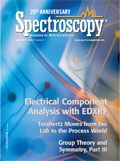Article
Spectroscopy
Spectroscopy
Avoiding the "W" Recovery
Author(s):
By all accounts, the spectroscopy market and the materials analysis market in general have weathered the recession and downward economic turn of the last couple of years very well. To begin with, it has been well documented that the effects of these difficult economic times have been felt less severely in the spectroscopy market compared to other markets, as the demand for instrumentation and services has remained at respectable levels.
By all accounts, the spectroscopy market and the materials analysis market in general have weathered the recession and downward economic turn of the last couple of years very well. To begin with, it has been well documented that the effects of these difficult economic times have been felt less severely in the spectroscopy market compared to other markets, as the demand for instrumentation and services has remained at respectable levels.

David Walsh
However, recently, the concern for many has shifted to avoiding the "W" recovery forecast by many experts over the next 12 months. With budget deficits growing, there is a feeling that markets such as academia may begin to recede as pressure on public spending grows, which will have a contagious effect on other sectors of the economy as well. Combating this concern will be emerging, high-growth areas of spectroscopic research, and several of these are covered extensively in this month's issue.
Terahertz technology is finding new applications each day, and as described in this month's "Laser and Optics Interface" column by Phil Taday, is now making a move to the process line, a development that could mean further growth for this emerging industry. Combine this application of cutting-edge techniques such as THz with innovative applications of more mature techniques such as EDXRF to electronics production, as described in this month's feature, and the field of spectroscopy is well positioned to avoid this dreaded "W" recovery pattern.
We hope readers will find articles such as these useful not only in their daily research work but also in their attempts to grasp the bigger picture in the materials analysis market. For as has been asserted in this space many times, if a topic is being covered in these pages, it is a safe bet that it is having an impact on the market as a whole.
Enjoy the issue.
David Walsh
Editor-in-Chief

Newsletter
Get essential updates on the latest spectroscopy technologies, regulatory standards, and best practices—subscribe today to Spectroscopy.


